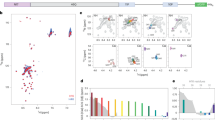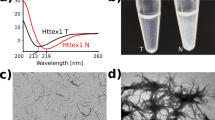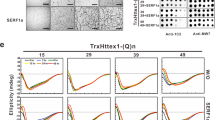Abstract
Simple polyglutamine (polyQ) peptides aggregate in vitro via a nucleated growth pathway directly yielding amyloid-like aggregates. We show here that the 17-amino-acid flanking sequence (HTTNT) N-terminal to the polyQ in the toxic huntingtin exon 1 fragment imparts onto this peptide a complex alternative aggregation mechanism. In isolation, the HTTNT peptide is a compact coil that resists aggregation. When polyQ is fused to this sequence, it induces in HTTNT, in a repeat-length dependent fashion, a more extended conformation that greatly enhances its aggregation into globular oligomers with HTTNT cores and exposed polyQ. In a second step, a new, amyloid-like aggregate is formed with a core composed of both HTTNT and polyQ. The results indicate unprecedented complexity in how primary sequence controls aggregation within a substantially disordered peptide and have implications for the molecular mechanism of Huntington's disease.
This is a preview of subscription content, access via your institution
Access options
Subscribe to this journal
Receive 12 print issues and online access
$189.00 per year
only $15.75 per issue
Buy this article
- Purchase on Springer Link
- Instant access to full article PDF
Prices may be subject to local taxes which are calculated during checkout









Similar content being viewed by others
References
Bates, G.P. & Benn, C. The polyglutamine diseases. in Huntington's Disease (eds. Bates, G.P., Harper, P.S. & Jones, L.) 429–472 (Oxford University Press, Oxford, 2002).
Andreson, J.M. et al. The relationship between CAG repeat length and age of onset differs for Huntington's disease patients with juvenile onset or adult onset. Ann. Hum. Genet. 71, 295–301 (2007).
Wetzel, R. Misfolding and aggregation in Huntington's disease and other expanded polyglutamine repeat diseases. in Protein Misfolding Diseases: Current and Emerging Principles and Therapies (eds. Dobson, C.M., Kelly, J.W. & Ramirez-Alvarado, M.) (Wiley, New York, in the press).
Arrasate, M., Mitra, S., Schweitzer, E.S., Segal, M.R. & Finkbeiner, S. Inclusion body formation reduces levels of mutant huntingtin and the risk of neuronal death. Nature 431, 805–810 (2004).
Chen, S., Ferrone, F. & Wetzel, R. Huntington's disease age-of-onset linked to polyglutamine aggregation nucleation. Proc. Natl. Acad. Sci. USA 99, 11884–11889 (2002).
Bhattacharyya, A.M., Thakur, A.K. & Wetzel, R. Polyglutamine aggregation nucleation: thermodynamics of a highly unfavorable protein folding reaction. Proc. Natl. Acad. Sci. USA 102, 15400–15405 (2005).
Wetzel, R. Chemical and physical properties of polyglutamine repeat sequences. in Genetic Instabilities and Neurological Diseases (eds. Wells, R.D. & Ashizawa, T.) 517–534 (Elsevier, San Diego, 2006).
Slepko, N. et al. Normal-repeat-length polyglutamine peptides accelerate aggregation nucleation and cytotoxicity of expanded polyglutamine proteins. Proc. Natl. Acad. Sci. USA 103, 14367–14372 (2006).
Scherzinger, E. et al. Huntingtin-encoded polyglutamine expansions form amyloid-like protein aggregates in vitro and in vivo. Cell 90, 549–558 (1997).
Poirier, M.A. et al. Huntingtin spheroids and protofibrils as precursors in polyglutamine fibrilization. J. Biol. Chem. 277, 41032–41037 (2002).
Wacker, J.L., Zareie, M.H., Fong, H., Sarikaya, M. & Muchowski, P.J. Hsp70 and Hsp40 attenuate formation of spherical and annular polyglutamine oligomers by partitioning monomer. Nat. Struct. Mol. Biol. 11, 1215–1222 (2004).
Caughey, B. & Lansbury, P.T. Protofibrils, pores, fibrils, and neurodegeneration: separating the responsible protein aggregates from the innocent bystanders. Annu. Rev. Neurosci. 26, 267–298 (2003).
Graham, R.K. et al. Cleavage at the caspase-6 site is required for neuronal dysfunction and degeneration due to mutant huntingtin. Cell 125, 1179–1191 (2006).
Bhattacharyya, A. et al. Oligoproline effects on polyglutamine conformation and aggregation. J. Mol. Biol. 355, 524–535 (2006).
Dyson, H.J. & Wright, P.E. Intrinsically unstructured proteins and their functions. Nat. Rev. Mol. Cell Biol. 6, 197–208 (2005).
Masino, L. et al. Characterization of the structure and the amyloidogenic properties of the Josephin domain of the polyglutamine-containing protein ataxin-3. J. Mol. Biol. 344, 1021–1035 (2004).
de Chiara, C., Menon, R.P., Dal Piaz, F., Calder, L. & Pastore, A. Polyglutamine is not all: the functional role of the AXH domain in the ataxin-1 protein. J. Mol. Biol. 354, 883–893 (2005).
Bulone, D., Masino, L., Thomas, D.J., San Biagio, P.L. & Pastore, A. The innterplay between PolyQ and protein context delays aggregation by forming a reservoir of protofibrils. PLoS ONE 1, e111 (2006).
Ellisdon, A.M., Thomas, B. & Bottomley, S.P. The two-stage pathway of ataxin-3 fibrillogenesis involves a polyglutamine-independent step. J. Biol. Chem. 281, 16888–16896 (2006).
Ignatova, Z. & Gierasch, L.M. Extended polyglutamine tracts cause aggregation and structural perturbation of an adjacent β-barrel protein. J. Biol. Chem. 281, 12959–12967 (2006).
Ignatova, Z., Thakur, A.K., Wetzel, R. & Gierasch, L.M. In-cell aggregation of a polyglutamine-containing chimera is a multistep process initiated by the flanking sequence. J. Biol. Chem. 282, 36736–36743 (2007).
Duennwald, M.L., Jagadish, S., Muchowski, P.J. & Lindquist, S. Flanking sequences profoundly alter polyglutamine toxicity in yeast. Proc. Natl. Acad. Sci. USA 103, 11045–11050 (2006).
Rockabrand, E. et al. The first 17 amino acids of Huntingtin modulate its sub-cellular localization, aggregation and effects on calcium homeostasis. Hum. Mol. Genet. 16, 61–77 (2007).
O'Nuallain, B. et al. Kinetics and thermodynamics of amyloid assembly using a high-performance liquid chromatography-based sedimentation assay. Methods Enzymol. 413, 34–74 (2006).
Chen, S., Berthelier, V., Yang, W. & Wetzel, R. Polyglutamine aggregation behavior in vitro supports a recruitment mechanism of cytotoxicity. J. Mol. Biol. 311, 173–182 (2001).
Ferrone, F. Analysis of protein aggregation kinetics. Methods Enzymol. 309, 256–274 (1999).
Modler, A.J. et al. Polymerization of proteins into amyloid protofibrils shares common critical oligomeric states but differs in the mechanisms of their formation. Amyloid 11, 215–231 (2004).
Bieschke, J. et al. Small molecule oxidation products trigger disease-associated protein misfolding. Acc. Chem. Res. 39, 611–619 (2006).
Rousseau, F., Schymkowitz, J. & Serrano, L. Protein aggregation and amyloidosis: confusion of the kinds? Curr. Opin. Struct. Biol. 16, 118–126 (2006).
Wetzel, R. Mutations and off-pathway aggregation. Trends Biotechnol. 12, 193–198 (1994).
Marqusee, S., Robbins, V.H. & Baldwin, R.L. Unusually stable helix formation in short alanine-based peptides. Proc. Natl. Acad. Sci. USA 86, 5286–5290 (1989).
Schuler, B., Lipman, E.A. & Eaton, W.A. Probing the free-energy surface for protein folding with single-molecule fluorescence spectroscopy. Nature 419, 743–747 (2002).
Wu, P. & Brand, L. Resonance energy transfer: methods and applications. Anal. Biochem. 218, 1–13 (1994).
Fitzkee, N.C. & Rose, G.D. Reassessing random-coil statistics in unfolded proteins. Proc. Natl. Acad. Sci. USA 101, 12497–12502 (2004).
Atwal, R.S. et al. Huntingtin has a membrane association signal that can modulate huntingtin aggregation, nuclear entry and toxicity. Hum. Mol. Genet. 16, 2600–2615 (2007).
Whitmore, L. & Wallace, B.A. DICHROWEB, an online server for protein secondary structure analyses from circular dichroism spectroscopic data. Nucleic Acids Res. 32, W668–W673 (2004).
Mohan, A. et al. Analysis of molecular recognition features (MoRFs). J. Mol. Biol. 362, 1043–1059 (2006).
LeVine, H. Quantification of β-sheet amyloid fibril structures with thioflavin T. Methods Enzymol. 309, 274–284 (1999).
O'Nuallain, B., Williams, A.D., Westermark, P. & Wetzel, R. Seeding specificity in amyloid growth induced by heterologous fibrils. J. Biol. Chem. 279, 17490–17499 (2004).
Serio, T.R. et al. Nucleated conformational conversion and the replication of conformational information by a prion determinant. Science 289, 1317–1321 (2000).
Kodali, R. & Wetzel, R. Polymorphism in the intermediates and products of amyloid assembly. Curr. Opin. Struct. Biol. 17, 48–57 (2007).
Bevivino, A.E. & Loll, P.J. An expanded glutamine repeat destabilizes native ataxin-3 structure and mediates formation of parallel β-fibrils. Proc. Natl. Acad. Sci. USA 98, 11955–11960 (2001).
Bracken, C., Iakoucheva, L.M., Romero, P.R. & Dunker, A.K. Combining prediction, computation and experiment for the characterization of protein disorder. Curr. Opin. Struct. Biol. 14, 570–576 (2004).
Hammarstrom, P. et al. Structural mapping of an aggregation nucleation site in a molten globule intermediate. J. Biol. Chem. 274, 32897–32903 (1999).
Cattaneo, E. et al. Loss of normal huntingtin function: new developments in Huntington's disease research. Trends Neurosci. 24, 182–188 (2001).
Kaltenbach, L.S. et al. Huntingtin interacting proteins are genetic modifiers of neurodegeneration. PLoS Genet. 3, e82 (2007).
Nozaki, K., Onodera, O., Takano, H. & Tsuji, S. Amino acid sequences flanking polyglutamine stretches influence their potential for aggregate formation. Neuroreport 12, 3357–3364 (2001).
Steffan, J.S. et al. SUMO modification of Huntingtin and Huntington's disease pathology. Science 304, 100–104 (2004).
Colby, D.W. et al. Potent inhibition of huntingtin aggregation and cytotoxicity by a disulfide bond-free single-domain intracellular antibody. Proc. Natl. Acad. Sci. USA 101, 17616–17621 (2004).
Wanderer, J. & Morton, A.J. Differential morphology and composition of inclusions in the R6/2 mouse and PC12 cell models of Huntington's disease. Histochem. Cell Biol. 127, 473–484 (2007).
Chen, S., Berthelier, V., Hamilton, J.B., O'Nuallain, B. & Wetzel, R. Amyloid-like features of polyglutamine aggregates and their assembly kinetics. Biochemistry 41, 7391–7399 (2002).
Liu, M. et al. Improved WATERGATE pulse sequences for solvent suppression in NMR spectroscopy. J. Magn. Reson. 132, 125–129 (1998).
Bax, A. & Davis, D.G. MLEV-17-based two-dimensional homonuclear magnetization transfer spectroscopy. J. Magn. Reson. 65, 355–360 (1985).
Schwarzinger, S. et al. Sequence-dependent correction of random coil NMR chemical shifts. J. Am. Chem. Soc. 123, 2970–2978 (2001).
Lakowicz, J.R. Principles of Fluoresence Spectroscopy 954 (Kluwer, New York, 2006).
Tcherkasskaya, O. & Ptitsyn, O.B. Direct energy transfer to study the 3D structure of non-native proteins: AGH complex in molten globule state of apomyoglobin. Protein Eng. 12, 485–490 (1999).
Ko, J., Ou, S. & Patterson, P.H. New anti-huntingtin monoclonal antibodies: implications for huntingtin conformation and its binding proteins. Brain Res. Bull. 56, 319–329 (2001).
Sreerama, N. & Woody, R.W. Estimation of protein secondary structure from circular dichroism spectra: comparison of CONTIN, SELCON, and CDSSTR methods with an expanded reference set. Anal. Biochem. 287, 252–260 (2000).
Jackson, M. & Mantsch, H.H. The use and misuse of FTIR spectroscopy in the determination of protein structure. Crit. Rev. Biochem. Mol. Biol. 30, 95–120 (1995).
Venyaminov, S. & Kalnin, N.N. Quantitative IR spectrophotometry of peptide compounds in water (H2O) solutions. I. Spectral parameters of amino acid residue absorption bands. Biopolymers 30, 1243–1257 (1990).
Acknowledgements
The authors acknowledge J. Ko and P. Patterson (California Institute of Technology) for the gift of the MW1 antibody, and T. Fullam (Allegheny College) for providing a set of aggregation kinetics data. We also acknowledge the following funding sources that contributed to the work described here: NIH R01 AG019322 (R.W.); Huntington's Disease Society of America postdoctoral fellowship (V.M.C.); NSF MCB-0444049 (T.P.C.); Petroleum Research Fund/American Chemical Society 43138-AC4 (T.P.C.); grant #4100026429 from the Commonwealth of Pennsylvania (A.M.G.).
Author information
Authors and Affiliations
Corresponding author
Rights and permissions
About this article
Cite this article
Thakur, A., Jayaraman, M., Mishra, R. et al. Polyglutamine disruption of the huntingtin exon 1 N terminus triggers a complex aggregation mechanism. Nat Struct Mol Biol 16, 380–389 (2009). https://doi.org/10.1038/nsmb.1570
Received:
Accepted:
Published:
Issue Date:
DOI: https://doi.org/10.1038/nsmb.1570
This article is cited by
-
A clinical study and future prospects for bioactive compounds and semi-synthetic molecules in the therapies for Huntington's disease
Molecular Neurobiology (2024)
-
Amyloid modifier SERF1a interacts with polyQ-expanded huntingtin-exon 1 via helical interactions and exacerbates polyQ-induced toxicity
Communications Biology (2023)
-
The structure of pathogenic huntingtin exon 1 defines the bases of its aggregation propensity
Nature Structural & Molecular Biology (2023)
-
The cytoprotective role of GM1 ganglioside in Huntington disease cells
Molecular Biology Reports (2022)
-
Nuclear and cytoplasmic huntingtin inclusions exhibit distinct biochemical composition, interactome and ultrastructural properties
Nature Communications (2021)



